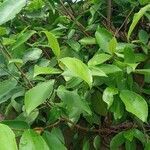Leaves almost distichous and alternate, sometimes subopposite; lamina ovate to elliptic or obovate, sometimes to oblong or subcircular, 2–16(20) x 1–12 cm., sometimes ± asymmetrical, subcoriaceous to coriaceous, apex shortly acuminate, sometimes acute, obtuse or rounded, base cuneate or occasionally subcordate, margin dentate to subentire; superior surface scabrous, hispidulous, the inferior surface scabrous, hispidulous or partly hirtellous to subtomentose; lateral veins 3–5(6) pairs; petiole 5–22(60) mm. long; stipules 2–5 mm. long, strigillose to strigose, caducous.
A fig. It is a tree. It grows 21 m tall. The trunk can be 50 cm across. It can have slight buttresses. It does not have aerial roots. It loses its leaves in the dry season. The leaves are rough like sandpaper. They have teeth around the edge. They are 12 cm long by 8 cm wide. The figs are in the axils of leaves or on lumps on the wood of last year's best branches. They occur singly or in pairs. They are pink or orange-red when ripe.
Figs in pairs or solitary in the leaf axils, just below the leaves or sometimes on the older wood; peduncle 5–10(15) mm. long; bracts 1–5, broadly ovate, scattered on the peduncle, 1–4 similar bracts on the receptacle outer surface; receptacle subglobose, 10–25 mm. in diam. when fresh, 8–15 mm. in diam. when dry, hispidulous, yellow, orange or reddish at maturity.
Leafy twigs 1-5 mm. thick, hispidulous.
Shrub or tree, up to 20(30) m. tall.
A deciduous tree, up to 70 ft. high
Coppice shoots with lobed leaves
Sap viscid, not milky
Very rough leaves
Smooth grey bark




